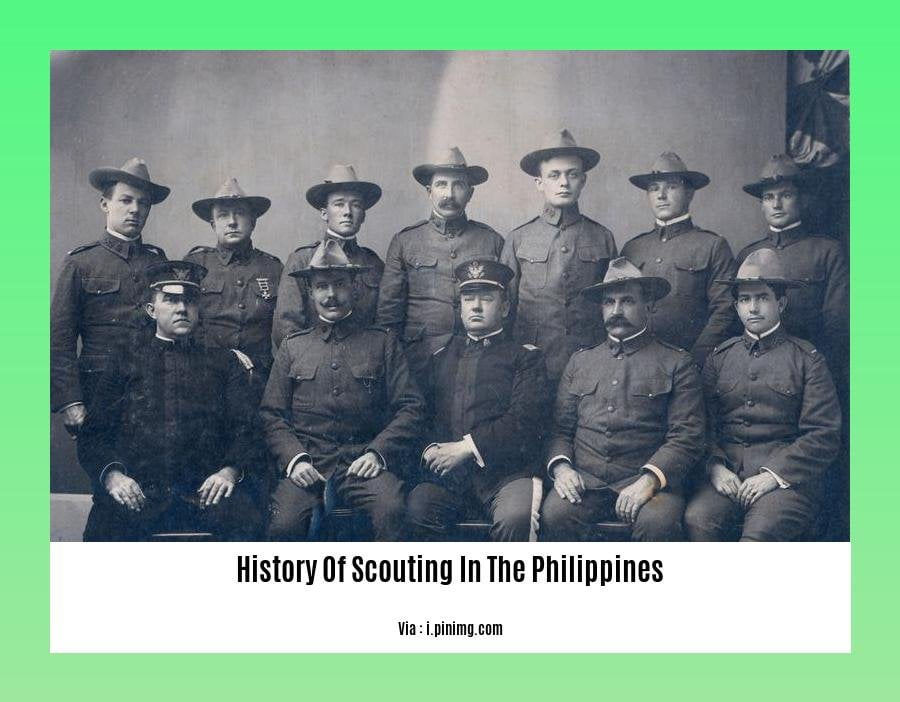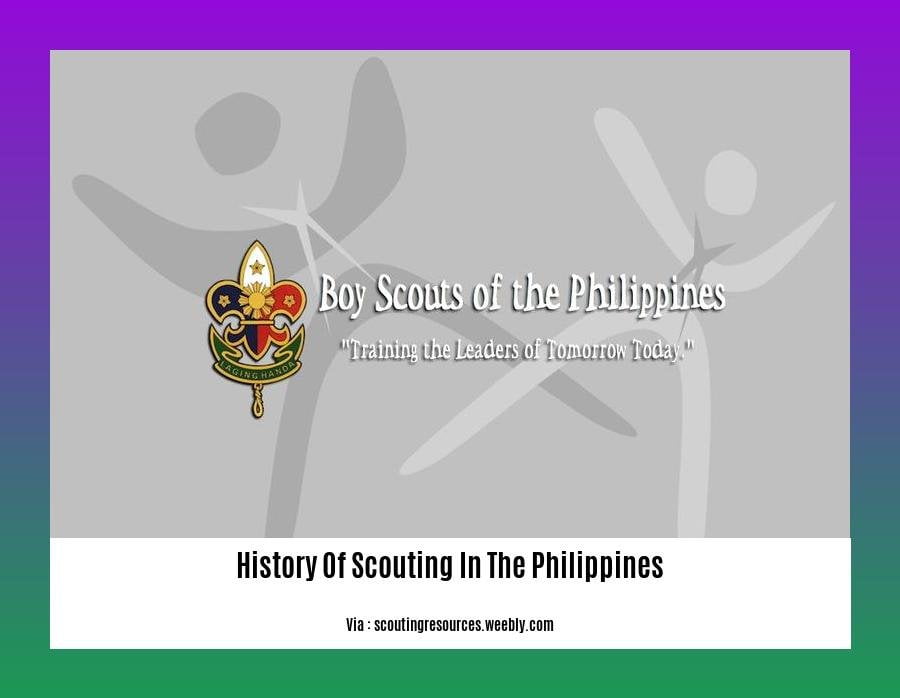Embark on a captivating journey through the annals of scouting in the Philippines as we unveil the profound legacy of values formation, leadership development, and nation-building in the country. From its humble beginnings to its enduring impact on shaping generations of Filipinos, let’s delve into the fascinating story of Scouting in the Philippines: A Legacy of Values, Leadership, and Nation-Building.
Key Takeaways:
Youth Scouting was introduced in the Philippines in 1910, in Manila by Elwood Stanley Brown of the YMCA.
The Boy Scouts of the Philippines (BSP) was founded in 1936 with Josephus Stevenot as its first president and Chief Scout.
In 1960, the BSP underwent nationalization, emphasizing Philippine motifs and culture in its scouting program.
Several notable scouting organizations in the Philippines were founded before the establishment of the BSP, such as the Boy Scouts of Calivo in 1922 and the Lorillard Spencer Troop in 1914, Zamboanga City.
The Golden Jubilee Jamboree in 1973 and the Philippine Scouting Centennial Jamboree in 2014 celebrated important milestones in the history of scouting in the Philippines.
History of Scouting in the Philippines


Scouting in the Philippines traces its roots back to initiatives that sowed the seeds for the nation’s future scouting movement. From early endeavors like the Boy Scouts of America Philippine Islands Council No. 545, the Boy Scouts of Calivo, and the Lorillard Spencer Troop, we see a rich tapestry of scouting initiatives that flourished in different parts of the Philippines.
One pivotal figure in the Philippines’ scouting history was Elwood Stanley Brown of the YMCA. In 1910, his pioneering efforts in Manila marked the introduction of Youth Scouting to the Philippine shores. This moment sparked a journey of growth and transformation that would eventually shape scouting’s enduring legacy in the country.
The Boy Scouts of the Philippines (BSP) emerged in 1936 as a beacon of scouting ideals, forged through a legislative act that recognized the immense value of scouting in shaping the nation’s youth. With Josephus Stevenot at the helm as its first president and Chief Scout, the BSP embarked on a mission to instill values, leadership skills, and a deep sense of nationhood in Filipino scouts.
In 1960, a milestone of nationalization was achieved. This decisive step saw American symbols replaced by Philippine motifs, culminating in a scouting program that resonated more profoundly with the nation’s cultural identity and heritage. It marked a turning point towards a distinctly Filipino scouting movement, solidifying its role in nation-building.
Over the decades, milestones continued to be etched into the annals of Philippine scouting. The 1973 Golden Jubilee Jamboree stood as a testament to the solidarity and achievements of the BSA Philippine Islands Council No. 545, while the 2014 “Philippine Scouting Centennial Jamboree” celebrated the century-long legacy of the Lorillard Spencer Troop, a testament to the enduring impact of scouting in various regions.
The history of scouting in the Philippines is a mosaic of dedicated individuals, organizations, and events that have interwoven to create a legacy of values, leadership, and nation-building. Tracing the evolution of scouting from its early roots to its current state, we gain a deep appreciation for the profound role it has played in shaping Filipino youth and contributing to the nation’s progress.
Dive into the fascinating journey of social studies education in Nigeria, where the curriculum has evolved, teaching methodologies have shifted, and the significance of this subject in shaping the nation’s future citizens is explored in-depth. history of social studies education in nigeria
In England, the evolution of social work is a compelling narrative that spans centuries, reflecting changing societal attitudes, economic transformations, and legislative frameworks. Uncover the stories of trailblazing individuals and organizations that have shaped the profession’s identity. history of social work in england
The history of social work in the United Kingdom is a tapestry of dedication, innovation, and resilience, revealing how this profession has responded to evolving social challenges, shaped public policy, and continues to make a profound impact on the well-being of communities. history of social work in uk
History Of Scouting In The Philippines Ppt
Scouting’s Arrival
The roots of scouting in the Philippines trace back to 1910. With Elwood Stanley Brown at the helm, the YMCA introduced the concept to Filipino youth in Manila. In 1914, the first Boy Scout troop, comprising Filipino Muslim boys, was formed in Zamboanga City, marking the beginning of a movement that would shape the lives of countless Filipinos.
Formal Establishment
In 1935, a significant milestone was reached with the official establishment of the Boy Scouts of the Philippines (BSP). Recognized by the World Scout Conference in 1946, the BSP became an integral part of the global scouting movement, fostering camaraderie and shared values worldwide.
World War II Era and Beyond
During World War II, the BSP demonstrated its resilience and dedication to the nation’s welfare. Scouts played a vital role in the resistance against the Japanese occupation, delivering messages, providing aid to guerrilla units, and contributing to the war effort in significant ways.
Post-War Resurgence
In the aftermath of the war, the BSP emerged with renewed vigor. The organization underwent nationalization in 1960, replacing American symbols with Philippine motifs to strengthen its identity as a Filipino institution.
Legacy of Values, Leadership, and Nation-Building
The Boy Scouts of the Philippines has had a profound impact on the lives of millions of Filipinos, instilling in them values of discipline, perseverance, and leadership. Over the years, the BSP has played a crucial role in nation-building, promoting the development of responsible and patriotic citizens.
Key Takeaways:
- Scouting was brought to the Philippines in 1910, and the first Boy Scout troop was established in Zamboanga City in 1914.
- The Boy Scouts of the Philippines (BSP) was formally established in 1935 and became part of the World Scout Movement in 1946.
- During World War II, BSP members played a vital role in the resistance against the Japanese occupation.
- After the war, the BSP underwent nationalization in 1960, replacing American symbols with Philippine motifs.
- Scouting in the Philippines has had a significant impact on shaping values, developing leadership, and contributing to nation-building.
Sources:
1
2
FAQ
Q1: When and by whom was scouting introduced in the Philippines?
A1: Scouting was introduced in the Philippines in 1910 in Manila by Elwood Stanley Brown of the YMCA.
Q2: What is the significance of the year 1936 for scouting in the Philippines?
A2: In 1936, the Boy Scouts of the Philippines (BSP) was established through a legislative act, marking a significant milestone in the development of scouting in the country.
Q3: What was the role of scouting during World War II in the Philippines?
A3: During World War II, the BSP remained active and played a crucial role in the resistance against the Japanese occupation, demonstrating the organization’s commitment to serving the nation.
Q4: When did the BSP gain international recognition?
A4: The BSP was recognized as a member of the World Scout Movement by the World Scout Conference in 1946, solidifying its position as a part of the global scouting community.
Q5: What year did the Philippines celebrate its Scouting Centennial Jamboree?
A5: The Philippines celebrated its Scouting Centennial Jamboree in 2014, marking 100 years since the founding of the Lorillard Spencer Troop, one of the earliest scouting troops in the country.
- Unlock Water’s Symbolism: A Cross-Cultural Exploration - April 20, 2025
- Identify Black and White Snakes: Venomous or Harmless? - April 20, 2025
- Unlocking Potential: Origins High School’s NYC Story - April 20, 2025















